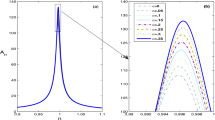Abstract
A new three-dimensional fundamental solution to the Stokes flow was proposed by transforming the solid harmonic functions in Lamb's solution into expressions in terms of the oblate spheroidal coordinates. These fundamental solutions are advantageous in treating flows past an arbitrary number of arbitrarily positioned and oriented oblate spheroids. The least squares technique was adopted herein so that the convergence difficulties often encountered in solving three-dimensional problems were completely avoided. The examples demonstrate that present approach is highly accurate, consistently stable and computationally efficient.
The oblate spheroid may be used to model a variety of particle shapes between a circular disk and a sphere. For the first time, the effect of various geometric factors on the forces and torques exerted on two oblate spheroids were systematically studied by using the proposed fundamental solutions. The generality of this approach was illustrated by two problems of three spheroids.
Similar content being viewed by others
References
Weinbaum S, Ganatos P, YAN Zong-yi. Numerical multipole and boundary integral equation techniques in Stokes flow[J].Ann Rev Fluid Mech, 1990,22: 275–316.
Gluckman MJ, Pfeffer R, Weinbaum S. A new technique for treating multiparticle slow viscous flow: axisymmetric flow past spheres and spheroids[J].J Fluid Mech, 1971,50(4): 705–740.
Guckman MJ, Weinbaum S, Pfeffer R. Axisymmetric slow viscous flow past an arbitrary convex body of revolution[J].J Fluid Mech, 1972,55(4): 677–709.
Ganatos P, Pfeffer R, Weinbaum S. A numerical-solution technique for three-dimensional Stokes flows, with application to the motion of strongly interacting spheres in a plane[J].J Fluid Mech, 1978,84(1): 79–111.
Yan ZY, Weinbaum S, Ganatos P, et al. The three-dimensional hydrodynamic interaction, of a finite sphere with a circular orifice at low Reynolds number[J].J Fluid Mech, 1987,174: 39–68.
Hassonjee Q, Ganatos P, Pfeffer R. A strong-interaction, theory for the motion of arbitrary three-dimensional clusters of spherical particles at low Reynolds number[J].J Fluid Mech, 1988,197: 1–37.
Leichtberg S, Peffer R, Weinbaum S. Stokes flow past finite coaxial clusters of spheres in a circular cylinder[J].Int J Multiphase Flow, 1976,3(2): 147–169.
Ganatos P, Weinbaum S, Pfeffer R. A strong interaction theory for the creeping motion of a sphere between plane parallel boundaries. Part 1. Perpendicular motion[J].J Fluid Mech, 1980,99(4): 739–753.
Ganatos P, Pfeffer R, Weinbaum S. A strong interaction theory for the creeping motion of a sphere between plane parallel boundaries. Part 2. Parallel motion[J].J Fluid Mech, 1980,99(4): 755–783.
Dagan Z, Weinbaum S, Pfeffer R. General theory for the creeping motion of a finite sphere along the axis of a circular orifice[J].J Fluid Mech, 1982,117: 143–170.
Yoon BJ, Kim S. A boundary collocation method for the motion of two spheroids in Stokes flow: hydrodynamic and colloidal interactions[J].Int J Multiphase Flow, 1990,16(4): 639–649.
Hsu R, Ganatos P. The motion of a rigid body in viscous fluid boundary by a plane wall[J].J Fluid Mech, 1989,207: 29–72.
SHI Cang-chueng, WANG Wei-guo, WU Wang-yi. The axisymmetric creeping flow in an infinite long circular cone with a sphere moving along the axis of symmetry[J].Acta Scientiarum Naturalium Universitatis Pekinensis, 1988,24(1): 85–94. (in Chinese with English abstract)
Lamb H.Hydrodynamics[M]. 6th edn. New York: Dover, 1945.
Happel J, Brenner H.Low Reynolds Number Hydrodynamics[M]. 2nd edn. The Hague: Martinus Noordhoff Publishers, 1973.
Goldman AJ, Cox RG, Brenner H. The slow motion of two identical arbitrarily oriented spheres through a viscous fluid[J].Chem Eng Sci., 1966,21(12): 1151–1170.
Author information
Authors and Affiliations
Additional information
Contributed by WU Wang-yi
Foundation item: the National Natural Science Foundation of China (86030028, 38970244)
Biography: ZHUANG Hong, (1965-), Professor, Ph.D.
Rights and permissions
About this article
Cite this article
Hong, Z., Zong-yi, Y. & Wang-yi, W. The three-dimensional fundamental solution to Stokes flow in the oblate spheroidal coordinates with applications to multiples spheroid problems. Appl Math Mech 23, 514–534 (2002). https://doi.org/10.1007/BF02437770
Received:
Revised:
Issue Date:
DOI: https://doi.org/10.1007/BF02437770
Key words
- Stokes flow
- fundamental solution
- three-dimension
- oblate spheroid
- multipole collocation
- least squares method
- low Reynolds number
- multiple particles



